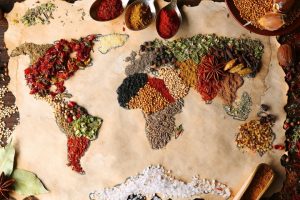Food is not only meant for nourishment but also carries a message. A taste of food could take you to other lands showcasing the culture and history of that place. Identity in terms of cuisine is largely shaped by regional cuisine. People have fond memories of their experiences with certain foods as comforting as Italian pasta or bold and screaming at all their senses as Sichuan hotpot.
Have you ever thought why certain things are preferred as ingredients in certain places? Or even how certain generations have changed the tastes of their communities? Within this landscape of regional tastes, let us engage in the debate as to what is unique in each region with respect to cuisine and, most importantly, why such cuisine recognition is of importance even now. Grab your fork; it’s ready for a delicious tour!
The Impact of Geography and Climate on the Cuisine:
The location of a country or region and its climatic conditions are crucial factors in the formation of the tastes of local cuisines. Natural physical features of every region determine the taste of the local products that can be cultivated or processed in the area. Areas by beaches are dominated by seafood, while areas that are hilly could have more starchy food and tubers. Climate also controls the German food supplies for certain times of the year. All fruits and spices tend to grow in hotter climates, therefore producing rich, flavourful, and aromatic dishes. However, this is also the case that many systems exist in areas that lie in cooler climates, as they tend to depend on food preservation till the weather warms up.
Food habits develop as society changes in order to take advantage of available food. The result is a cauldron of flavours shaped by the type of soil, rainfall, and even height. This rich interaction between geography and cuisine demonstrates how food practices are entrenched in land as culture, a reflection of the relation of nature and culture in terms of food.
Cultural and Historical Factors Influencing Regional Cuisines:
Culture and history are fundamental aspects that define the regional tastes in cooking. Concerning traditions, every zone has its essentials based on its relocation, commerce, and colonisation. These movements brought about changes and incorporated new ingredients and cooking styles. In the surrounding populations, some crops are celebrated in the form of local days, and this orchestrates them deep in the identities of those communities. Every generation passes on the recipes and incorporates and relates them to different experiences, but the key tenets are retained.
Some historical occurrences can impact cuisines permanently. For example, the spice trade led to the increase in culinary hot spots across many regions. Additional factors, such as religious tolerance, induce flavour as some foods are consistently eaten on festive or observational occasions. The outcome of this amalgamation is the development of various cuisines with rich stories about their origins. As time goes on, some of such processes will however not be practiced, and in memory, they will be observed among people who wish to continue with culture through food.
Famous foods and ingredients in Various Regions:
Every region has exclusive treasures that reveal the history and progress regarding cuisine. Consider Spain and its flavourful paella, heady with seafood and saffron with a Mediterranean touch. You have to agree that it is also Italian when you say a creamy risotto since it features different kinds of rice from the region. Every spoon has a story from the mountainous regions, where they have mushroom-flavoured ones, or the coastal towns where they are packed with seafood.
On to Asia, where we have India’s biryani, which camouflages in every setting owing to the aromatic spices of the national dish. Here, individual communities create their own variations from all over the rice based dish, with layers of meat included in every state. Further up north in Mexico, the mole sauce holds culinary history taut just like the rest of the food forward due to its savour with rich chiles and chocolate. Food goes beyond South America—Jewish cuisine is currently paradigm. It’s tangible: lovingly prepared by home cooks over the centuries. Every exciting dish is more than nutrition; it’s an ode to a region—what flora and fauna are found there and how people use them lovingly for cooking.
The Globalisation of Barrier Free Adoption of Regional Cuisine:
Food has benefitted greatly from globalisation. Ingredients and recipes no longer remain bound to a particular region. A lot of classic culinary practices today use spices or na hōhǵōhȯŋ techniques learnt from other places. These alterations usually give rise to interesting tastes, but they usually alter the meaning of these dishes as well.
When western franchises venture into new territories, they often replace small local restaurants that used to offer authentic cuisines. In place of local cherished tastes and creativity, local dishes are commandeered by fast food outlets, which churn out quick-to-make dishes that are not necessarily native. Still, globalisation has its good sides too. It promotes cultural exchange, which enables people to taste foods from different countries without going to that particular country. Food shows do the same function and also urge chefs to mix cuisines but still stay somewhat true to the roots of the foods and the chefs as well.
There are those whose cultures are fast to arrive at new changes and new incorporations and those who will not want any form of feature from foreign entities introduced in their dishes. The integration of new food customs and adherence to old ones continues to be a thin line, which is nevertheless of very high importance.
Utilising Complementary Traditional Local Dishes:
The need to preserve regional cuisine is equally important in any cultural preservation undertaking. The use of indigenous products and traditional practices expresses narratives of every locality. Particularly a farmer’s market is so busy because of this exchange activity. In this case, local farmers sell seasonal fruit and vegetables that local chefs use for preparing their meals with respect to the land. Encouraging these types of actions helps create a bridge between them and the consumers.
This process of preservation involves the use of workshops and cooking classes as well. They help people get some practical exposure to some native dishes that have been preserved over time. This not only keeps certain skills within the society but rekindles the interest in the art among the young cooks. The internet, and more specifically, social media, is now gaining prominence in preserving and promoting authentic Huaiyang cuisine. Uploading recipe videos, practical tips, and culinary stories helps to promote culinary culture, specifically in this case less popularly known regional cuisines.
Conclusion:
Regional cuisines are blends of historical, cultural, and geographical spices. Every mouthful displayed by a culinary creation reveals concern based on the culture and environment. While undergoing this adventure of different cultures in terms of cuisine, it is obvious that food is not mere food. Food connects us to culture and society. Maintaining these tastes does not mean we do not value our history, but we respect it and move on. How the chefs have been changing these common meals is that although the common meals are not new to them, some of them have travelled with their civilisation.
Engagement with regional cuisine emphasises the appreciation of the different ingredients and the cooking styles used. It dares to go further than that, to venture into the unknown. Appreciating cultural diversity through regional cuisines makes our tongues dance and our minds expand. These quests tackle a problem of culinary creativity and satisfaction—how to taste the world with every dish.
FAQs:
1. What characteristics define a regional flavour?
Regional tastes are derived from local products and methods specific to the region’s cultures and the natives. These are largely indicative of the region and the climate, which determines the products that are grown or raised in those areas.
2. What role does climate play in the cuisine?
Climate is quite important in determining which type of crop can be cultivated in the region. For instance, people who live near seas take more seafood due to access to sea food, while people in dry areas depend more on foods like cereals and other drought-resistant plants.
3. Is there any dish that is considered representative of a particular region?
For sure! What would be associated with pizza? Surely, it will be the City of Naples (the region of Italy). And in TEBI it will be the presence of gumbo characteristic of Louisiana. Yes, each and every one of them belongs wholly to a specific place and comes with its history.
4. In what way has globalisation impacted the traditional cuisines across the world?
To correct this situation, a combination of two cuisines is expected at the end, which is called a fusion. While this enhances splendour, it arrests some of the traditional tastes, which will tend to be miserable to some people as all global tongues tend to blend into one.
5. How can the local cuisine be modelled for the individual in a way that food is captured?
People prefer to consume traditional dishes and know the local farmer’s market and/or small restaurants. Mastering family recipes makes sure that these flavours become an integral part of humanity’s cultural legacy.




